12 Best Native Plants for Atlanta, GA
BY MELANIE JOSEPH | JUNE 18TH, 2019 | ATLANTA, LAWN CAREWith Atlanta’s moderate climate and ample rainfall, it’s home to a variety of beautiful native plants that can add color and texture to your garden. As you design your landscape, note that plants native to Atlanta offer several advantages over non-native species.
- Native plants have already adapted naturally to the humid subtropical climate of Atlanta.
- They promote biodiversity and provide beneficial wildlife, birds, and pollinators with food and shelter.
- These plants require far less maintenance than non-native species.
- Atlanta native plants have a natural resistance to local pests and diseases.
If you’re ready to create a more sustainable and diverse outdoor space that celebrates the natural beauty of Atlanta, here are 12 native plants to get you started.
In this article, we’ll cover:
- 12 Best Native Plants for Your Atlanta Yard
- How to Choose Native Plants for Your Atlanta Landscape
- FAQ About Native Atlanta Plants
- Where to Find Native Plants in Atlanta
12 Best Native Plants for Your Atlanta Yard
1. American Beautyberry (Callicarpa Americana)
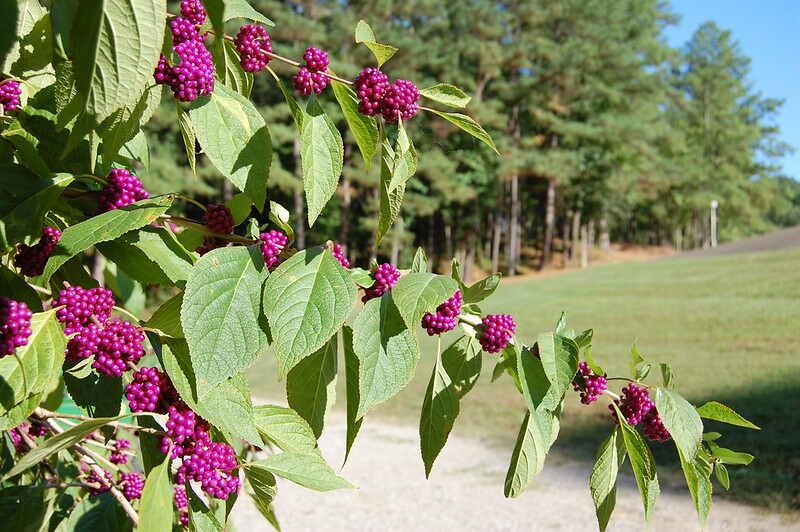
Photo Credit: Donald Lee Pardue / Flickr / CC BY 2.0
Native to the woodlands of the southeastern United States, American beautyberry is commonly found growing along forest perimeters and in the areas adjacent to the woods – spanning from Texas and Oklahoma all the way to Florida and up to Maryland.
This deciduous shrub is a member of the mint family and boasts bright purple berries that cluster along its stems from August to November. Its green leaves turn yellow in the fall, creating a striking contrast with the berries.
Atlanta homeowners love American beautyberry not just for its ornamental value but also for its practical uses. And if you’re an avid bird watcher, its berries are a favorite among local bird species. Since it’s relatively easy to grow and requires minimal care, this native plant is an excellent understory shrub for any Atlanta garden. For mass plantings, red chokeberry, oakleaf hydrangea, and great laurel are excellent companion plants.
Growth habit: Shrub
USDA Hardiness Zone: 6b-11
Mature size: 3-8 feet tall, 4-8 feet wide
Duration: Perennial
Foliage: Deciduous
Sunlight needs: Full sun and partial shade – needs at least four hours of exposure to direct sunlight per day
Soil preferences: Grows best in rich, organic loam soil but can tolerate a range of soil conditions
Water needs: Low – around 1 inch per week (during dry spells, it needs slow, deep watering)
Potential hazards: Non-toxic, but may cause mild stomach cramps if taken in large amounts
2. Bigleaf Magnolia (Magnolia macrophylla)
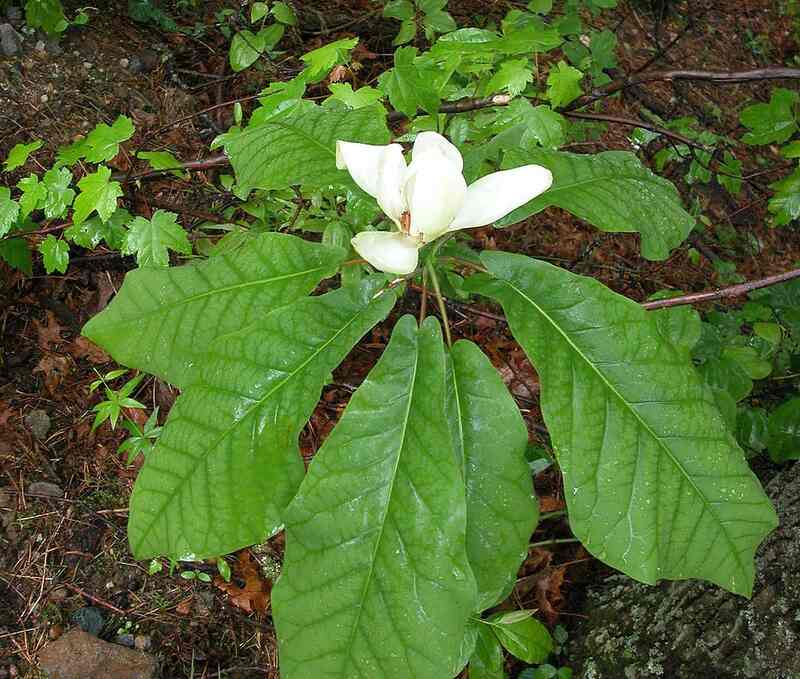
Photo Credit: Soil-Science.info / Wikimedia Commons / CC BY 2.0
Bigleaf Magnolias are beautiful hardwood trees with huge leaves and large, fragrant flowers. They’re particularly abundant in the Appalachian Mountains, but you can find them planted in a variety of settings throughout Atlanta, including public parks, gardens, and natural areas. Even the historic Oakland Cemetery has a number of bigleaf magnolias planted.
With its impressive size and striking appearance, the “queenliest of all the deciduous magnolias” is an excellent addition to woodland gardens or partially shaded areas. Its fragrant, creamy white flowers, which can be up to 12 inches in diameter, bloom in spring. During its bloom time, this shade tree attracts various pollinators, including bees and butterflies.
Growth habit: Tree
USDA Hardiness Zone: 5-8
Mature size: 30-60 feet tall, 20-30 feet wide
Duration: Perennial
Foliage: Deciduous – semi-evergreen in the deep South
Sunlight needs: Partial shade to full sun
Soil preferences: Grows best in loose, well-drained, and moist neutral to acidic soils
Water needs: Moderate – but can be drought-tolerant
Potential hazards: Non-toxic
3. Bottlebrush Buckeye (Aesculus parviflora)
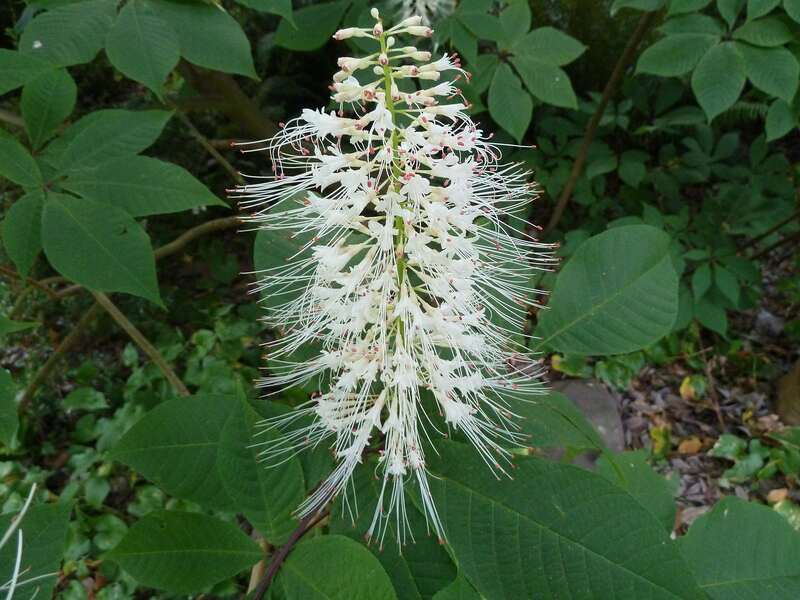
Photo Credit: Wendy Cutler / Wikimedia Commons / CC BY 2.0
Commonly found in western Georgia, bottlebrush buckeyes are so named for their showy, white flower clusters, which resemble the shape of a bottlebrush. The distinctive flowers typically bloom in late spring or early summer, attracting hummingbirds and butterflies.
In the fall, the shrub’s green leaves turn a lovely shade of yellow-green, providing additional visual interest. Low-maintenance yet impressive, the bottlebrush buckeye prefers well-drained, mostly wet soil and can tolerate partial shade. This border plant is excellent for lining driveways and property lines.
Growth habit: Shrub
USDA Hardiness Zone: 4-8
Mature size: 6-12 feet tall
Duration: Perennial
Foliage: Deciduous
Sunlight needs: Can tolerate partial shade but does best in full sun
Soil preferences: Well-drained, moist soil
Water needs: Low – infrequent but deep watering
Potential hazards: Very poisonous to both humans and animals
4. Butterfly Milkweed (Asclepias tuberosa)
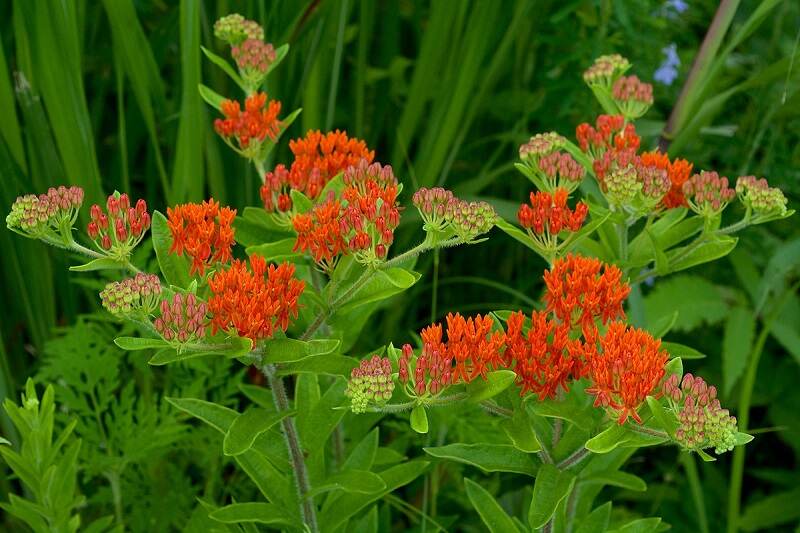
Photo Credit: Eric Hunt / Wikimedia Commons / CC BY-SA 4.0
Butterfly milkweed is popular for attracting pollinators, especially butterflies, to gardens and landscapes. In fact, it’s an important host plant for monarch butterflies, providing crucial habitat for their eggs and larvae. You’ll see butterfly milkweed planted in various outdoor spaces throughout Atlanta, such as gardens, nature centers, and parks like Piedmont Park.
Since this perennial herb can tolerate drought conditions and prefers full sun and well-drained soil, it’s perfect for planting in hot, dry areas. It typically blooms in the summer, producing clusters of bright orange flowers.
Growth habit: Herb
USDA Hardiness Zone: 4-10
Mature size: 1-2 feet tall
Duration: Perennial
Foliage: Deciduous
Sunlight needs: Full sun
Soil preferences: Well-drained, sandy soil
Water needs: Low
Potential hazards: All its parts are toxic and can even be fatal if consumed in large amounts
5. Carolina Silverbell (Halesia carolina)
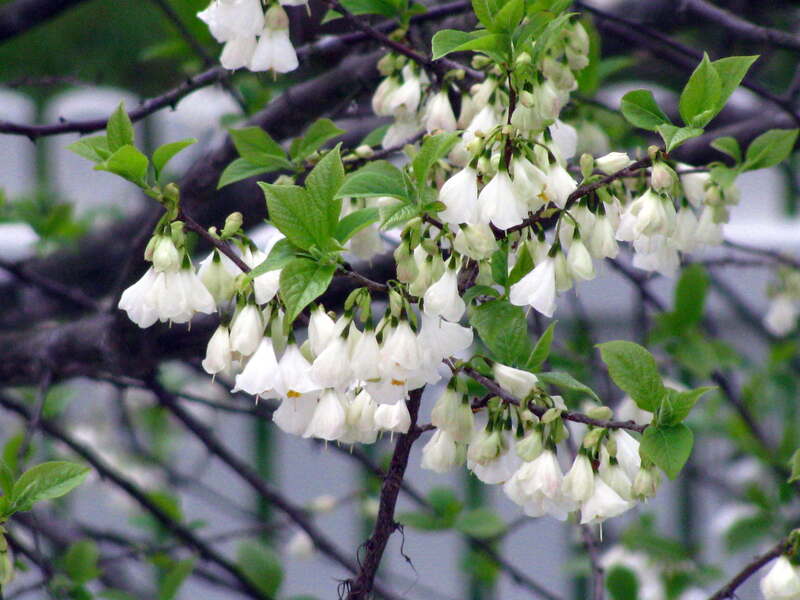
Photo Credit: The Alliance for Historic Hillsborough / Flickr / CC BY 2.0
Native to the southeastern United States, the Carolina silverbell is valued for its showy, bell-shaped flowers that bloom in the spring – which is typically before its leaves reappear. The drooping clusters of white or light pink flowers add aesthetic appeal while attracting bees and butterflies to your garden.
If you want to see how these ornamental trees look in person before you plant them in your backyard, you can go to Lullwater Conservation Garden, which has a collection of native plants.
Growth habit: Tree
USDA Hardiness Zone: 4-8
Mature size: 20-40 feet tall, 15-35 feet wide
Duration: Perennial
Foliage: Deciduous
Sunlight needs: Partial shade
Soil preferences: Well-drained, moist soil
Water needs: Moderate
Potential hazards: The seeds can be toxic and fatal to both humans and animals
6. Coastal Pepperbush (Clethra alnifolia)
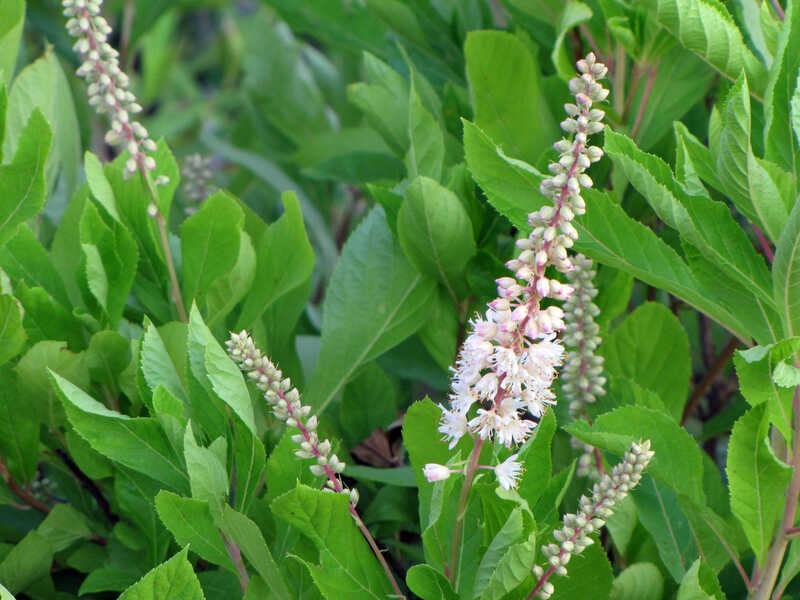
Photo Credit: Katja Schulz / Flickr / CC BY 2.0
Another perennial shrub native to Atlanta, Coastal Pepperbush, can be found in stream banks, swamps, and hillside bogs. Its bloom time is typically mid to late summer, producing fragrant white or pink flowers that are a favorite of butterflies, bees, and other pollinators. The plant’s leaves are deep green and can turn a lovely shade of yellow in the fall.
This native shrub can tolerate salt spray and is also a good choice for naturalizing – it can be used in rain gardens or as a groundcover to prevent erosion. With its fragrant flowers and adaptability to coastal environments, the Coastal Pepperbush is an excellent addition to any southeastern garden.
Growth habit: Shrub
USDA Hardiness Zone: 4-9
Mature size: 3-8 feet tall
Duration: Perennial
Foliage: Deciduous
Sunlight needs: Full sun to shade
Soil preferences: Moist to wet, acidic soil
Water needs: High
Potential hazards: Non-toxic
7. Coral Honeysuckle (Lonicera sempervirens)
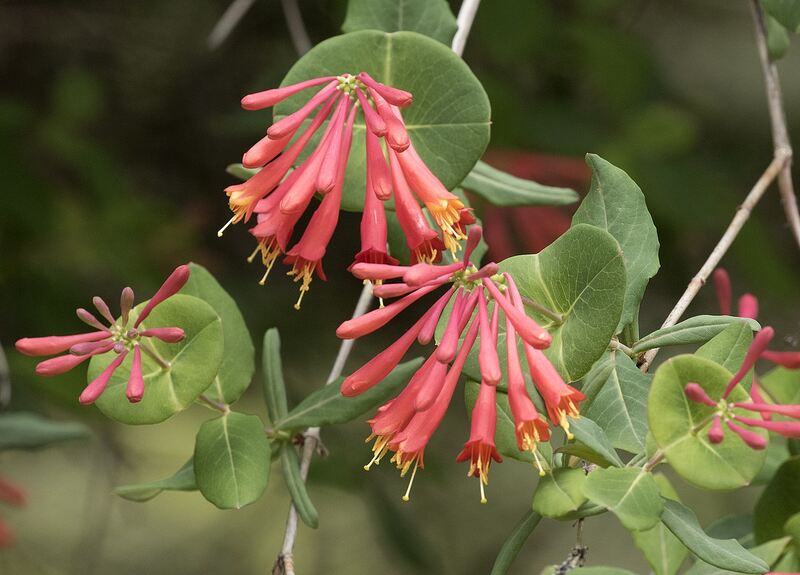
Photo Credit: Zeynel Cebeci / Wikimedia Commons / CC BY-SA 4.0
Coral honeysuckle is a beautiful vine that is native to the Southeast, including Georgia. It typically blooms in the spring, producing bright coral-red flowers that are a favorite of hummingbirds, bumblebees, and other pollinators. This perennial vine is also the larval host plant for both the snowberry clearwing moth and spring azure butterfly.
You can plant this vine to attract wildlife to your garden, as its berries are a food source for birds like the Eastern bluebird and American goldfinch. With its showy flowers and importance to wildlife, coral honeysuckle is an excellent addition to any southeastern garden focused on conservation and sustainability.
Growth habit: Vine
USDA Hardiness Zone: 4-10
Mature size: 3-20 feet long
Duration: Perennial
Foliage: Semi-evergreen to evergreen
Sunlight needs: Partial shade to full sun
Soil preferences: Grows in most soil types but prefers rich, well-drained soils
Water needs: Moderate
Potential hazards: Its red berries are toxic to humans but favored by birds
8. Crossvine (Bignonia capreolata)
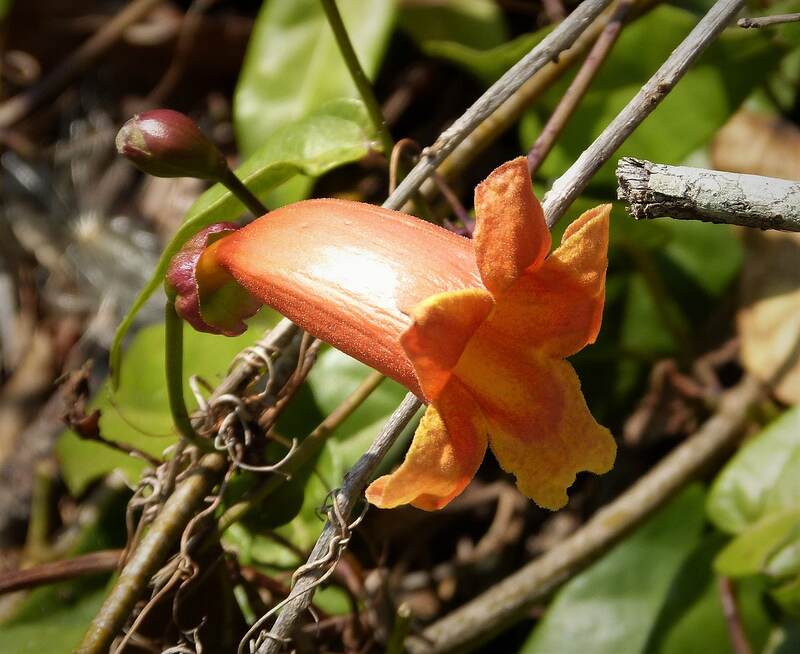
Photo Credit: gailhampshire / Wikimedia Commons / CC BY 2.0
A beautiful flowering vine, crossvine can climb up fences and trees – reaching up to 50 feet in length. The natural habitat for this fast-growing vine includes forests, lowlands, uplands, and clearings, but it can be an excellent choice for adding color and visual appeal to your Atlanta garden. This vine is also deer-resistant and can be used to cover unsightly fences or walls.
The cross-shaped pattern inside its trumpet-shaped, red-orange flowers is where this perennial vine got its common name. Its bloom time is usually in the spring but can be as early as late winter. Plus, its glossy green leaves can provide an attractive backdrop to the flowers. Allowing this vine to spread out horizontally on a sun-drenched incline would make for excellent groundcover.
Growth habit: Vine
USDA Hardiness Zone: 6-9
Mature size: 36-50 feet long
Duration: Perennial
Foliage: Deciduous to mostly evergreen
Sunlight needs: Full sun to part shade
Soil preferences: Dry to moist, well-drained, acidic soil
Water needs: Low to moderate
Potential hazards: Highly toxic to both humans and animals
9. Flowering Dogwood (Cornus florida)
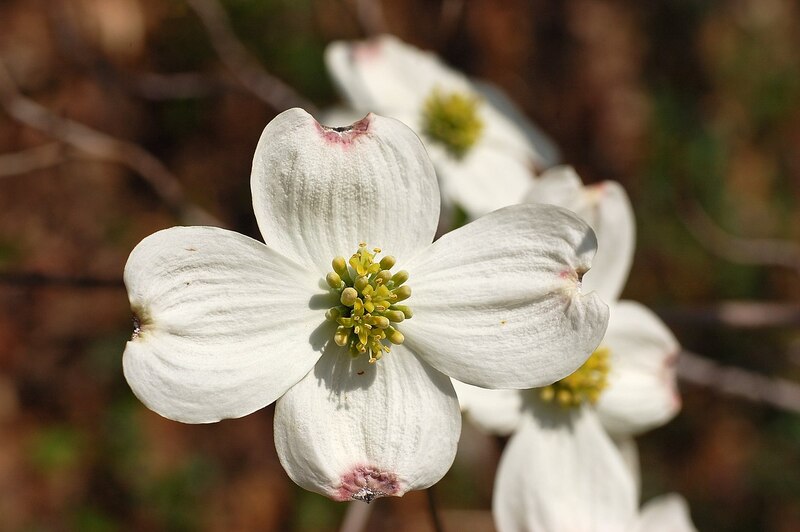
Photo Credit: Derek Ramsey / Wikimedia Commons / CC BY-SA 2.0
A common tree species in Atlanta, flowering dogwoods are planted throughout the city in parks and gardens, and along streets and sidewalks. The best places to see flowering dogwoods include Piedmont Park and Atlanta BeltLine Eastside Trail.
The flowering dogwood is so named for its showy, four-petaled flowers, which are white or pink and bloom in early spring before the tree’s leaves appear. The lovely flowers also attract pollinators like bees and butterflies to your garden. In the fall, the tree’s leaves turn a vibrant red before falling off, providing additional visual interest.
This deciduous tree is also an important food source for birds like the Eastern bluebird and northern cardinal, as its bright red berries provide nourishment in the fall and winter.
Growth habit: Tree
USDA Hardiness Zone: 5-9
Mature size: 20-65 feet tall
Duration: Perennial
Foliage: Deciduous
Sunlight needs: Part shade to full shade
Soil preferences: Dry to moist, well-drained, acidic soil
Water needs: Low
Potential hazards: The fruit is poisonous to humans
10. Mountain Azalea (Rhododendron canescens)
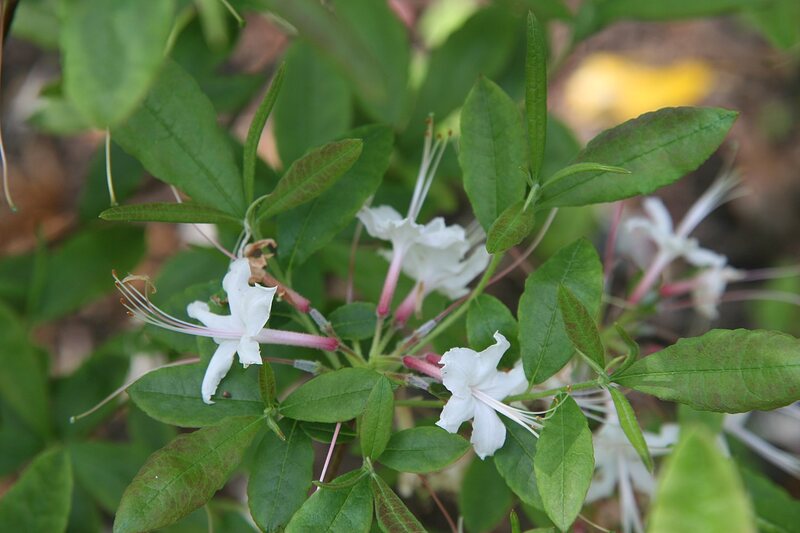
Photo Credit: David J. Stang / Wikimedia Commons / CC BY-SA 4.0
Native to the southeastern United States, mountain azaleas can be found growing in some parks and gardens throughout the Atlanta area. It typically blooms in mid to late spring and provides any garden with a striking display of pink and white flowers. And during fall, its light green leaves turn a lovely yellow color.
Whether used as a specimen or planted in masses, the mountain azalea prefers moist, well-drained soil and partial shade, making it fantastic for planting in woodland gardens or other shaded areas. This perennial shrub is also an important source of nectar for pollinators like bees and butterflies, as well as a host plant for the caterpillars of the Eastern Tiger Swallowtail butterfly.
Growth habit: Shrub
USDA Hardiness Zone: 5-9
Mature size: Up to 8 feet tall
Duration: Perennial
Foliage: Deciduous
Sunlight needs: Partial shade
Soil preferences: Dry to moist, well-drained, acidic soil
Water needs: Moderate
Potential hazards: Highly toxic to both humans and animals
11. Mountain Silverbell (Halesia tetraptera)
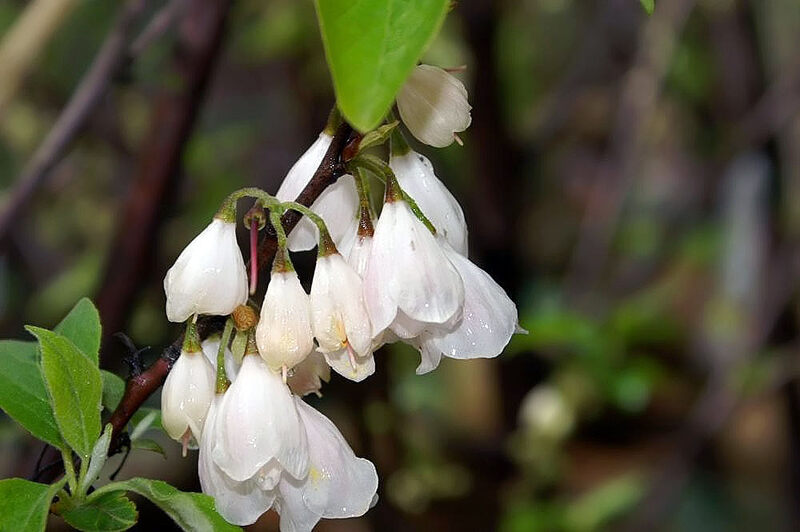
Photo Credit: David J. Stang / Wikimedia Commons / CC BY-SA 4.0
Mountain silverbell got its common name from its bell-shaped, white or pinkish flowers. It usually blooms in early spring before the tree’s leaves appear. In the fall, the tree’s leaves turn a vibrant yellow, providing additional visual interest.
This deciduous tree is relatively average in height compared to other larger, more common species, but it can grow up to a height of around 60 feet. It’s also an important food source for wildlife, as its fruit provides nourishment for birds like the Northern Bobwhite and wild turkey.
Growth habit: Tree
USDA Hardiness Zone: 4-8
Mature size: Up to 60 feet tall
Duration: Perennial
Foliage: Deciduous
Sunlight needs: Partial shade
Soil preferences: Well-drained, moist, organic loam soil
Water needs: Moderate
Potential hazards: Toxic to both humans and animals
12. Red Maple (Acer rubrum)
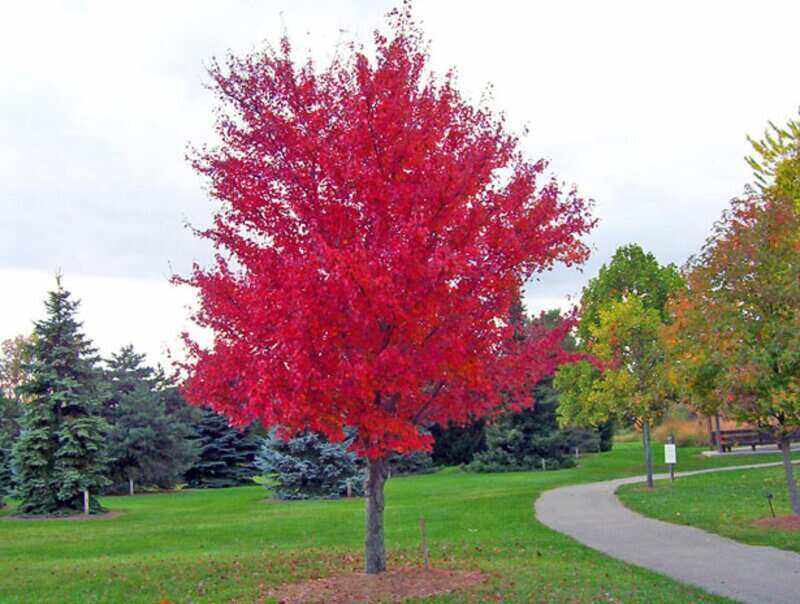
Red Maple Tree
Photo Credit: David Wagner / PublicDomainPictures / CC0 1.0
Native to eastern North America, red maples can be found from Canada to Florida and west to Texas. In Atlanta, you’ll find these perennial trees in parks and gardens like Grant Park and Atlanta Botanical Garden, as well as many residential neighborhoods throughout the city.
The red maple is so named for its red flowers, twigs, and leaves, which exude striking appeal throughout the year. The tree’s leaves are bright green in the spring and summer and turn a brilliant red or orange in the fall, making it an excellent choice for a shade tree that adds vibrant colors to your yard.
Growth habit: Tree
USDA Hardiness Zone: 3-9
Mature size: 40-60 feet tall, 25-45 feet wide
Duration: Perennial
Foliage: Deciduous
Sunlight needs: Full sun to partial shade
Soil preferences: Moist to dry, slightly acidic soil
Water needs: High
Potential hazards: Toxic, especially the wilted and dried leaves
How to Choose Native Plants for Your Atlanta Yard
As the capital and largest city in the state of Georgia, Atlanta boasts a diverse range of ecosystems, from the rolling hills of the Appalachian Mountains to the coastal plains of the Georgia Piedmont. This means that Atlanta is home to many native plants, including mountain azalea, American beautyberry, and flowering dogwoods.
However, not all native plants will thrive in every part of the city, as each area has its unique soil composition, rainfall patterns, and sun exposure.
When selecting native plants for your Atlanta landscape, consider each plant’s specific needs and the conditions of your yard. For example, plants that prefer acidic soil, such as mountain azaleas, may not do well in areas with alkaline soil. Similarly, plants that require full sun exposure, such as butterfly milkweed, may not thrive in shady areas.
By choosing native plants well-suited to your microclimate, you can create a beautiful and sustainable landscape that supports local wildlife and helps preserve Atlanta’s natural beauty.
Atlanta is generally considered to be in USDA hardiness zone 7b, with an average annual minimum temperature range of 5 to 10 degrees Fahrenheit. However, some parts of the city may fall into neighboring hardiness zones, depending on their specific microclimate and elevation. It’s crucial to keep your hardiness zone in mind when selecting plants for your landscape, as it can help you choose plants that are well-suited to the local climate and will thrive in your yard.
FAQ About Native Atlanta Plants
In general, a plant is considered native to a certain area if it has evolved and existed in that region for a long time. These plants have adapted to the local climate, soil, and other environmental conditions, making them well-suited to thrive in their native habitat.
The best time to plant native shrubs and flowering plants in Atlanta is typically in the fall or early spring. During these times, the temperatures are mild and rainfall is more abundant.
In the fall, planting should be done before the first frost, which typically occurs in late November or early December in Atlanta. Doing so gives the plants enough time to establish themselves before the winter cold.
In the spring, planting should be done after the last frost, which typically occurs in mid-to-late March in Atlanta. This way, the plants can take advantage of the longer days, warmer temperatures, and spring showers, which promote growth and establishment.
Native plants are essential for maintaining healthy and sustainable ecosystems. These plants have evolved over time to thrive in their specific environments, providing important ecological functions and supporting local wildlife.
Support biodiversity: One of the primary benefits of native plants is their ability to support biodiversity. Native plants provide food and habitat for various animals, including insects, birds, and mammals. For example, native flowering plants provide nectar and pollen for bees and butterflies, while native trees and shrubs provide shelter and nesting sites for birds and small mammals.
Support the soil: Native plants also help maintain soil health and prevent erosion. These plants have adapted to local soil conditions and help to build healthy soil structures, which in turn can reduce soil erosion and improve water quality.
Support the ecosystem: Native plants also require less water and fertilizer than non-native plants, making them more sustainable and cost-effective choices for landscaping. Plus, they can help create healthy and diverse ecosystems that are more resilient to invasive species.
When it comes to watering native plants, timing and frequency are key. Generally, it’s important to water deeply and infrequently rather than applying small amounts of water frequently. This helps to encourage deep root growth, which in turn promotes plant health and resilience.
Native plants should be watered when the top inch of the soil already feels dry to the touch. This may vary depending on local weather conditions, soil type, and the plant’s specific needs. During hot, dry weather, native plants may require more frequent watering to maintain proper moisture levels. But don’t overdo it to avoid issues like root rot.
It’s better to apply water directly to the base of the plant rather than spraying the leaves or flowers. This helps to prevent fungal growth and other plant diseases.
In addition to proper watering, it’s also important to mulch around the base of native plants. Doing so can help retain moisture in the soil and reduce water evaporation while also suppressing weed growth and promoting soil health.
Where to Find Native Plants in Atlanta
If you’re looking to incorporate more native plants into your Atlanta landscape, there are several local nurseries and plant resources to check out. However, it’s important to remember to source your plants ethically and never transplant them from the wild.
A great resource for finding information on trees, wildflowers, and other native plant species, the Georgia Native Plant Society also recommends the following local nurseries in the Atlanta area:
When selecting native plants for your landscape, consider the specific environmental conditions of your site, such as soil type, sun exposure, grass type, and drainage. But filling your yard with native plants is just one step in creating a sustainable and low-maintenance landscape. You also must consider other landscaping ideas that complement your native plants, such as mulching, composting, and using rain barrels to capture and reuse rainwater.
Transform your lawn into a beautiful and thriving garden with the help of a professional landscaper. Connect with a local landscaping pro today.
Main Image Credit: Pixnio